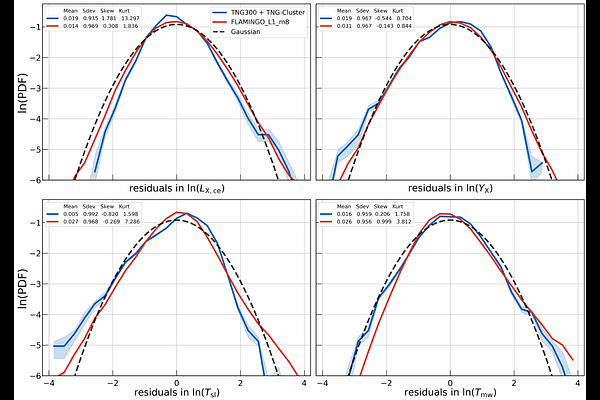Mass Proxy Quality of Massive Halo Properties in the IllustrisTNG and FLAMINGO Simulations: I. Hot Gas

Mass Proxy Quality of Massive Halo Properties in the IllustrisTNG and FLAMINGO Simulations: I. Hot Gas
Eddie Aljamal, August E. Evrard, Arya Farahi, Annalisa Pillepich, Dylan Nelson, Joop Schaye, Matthieu Schaller, Joey Braspenning
AbstractWe examine scale and redshift dependence of mass-property relations (MPRs) for five hot gas properties of two large group- and cluster-scale halo samples realized by the IllustrisTNG, TNG-Cluster and FLAMINGO cosmological hydrodynamical simulations. For intrinsic properties of i) hot gas mass ($M_{\rm gas}$), ii) spectroscopic-like temperature ($T_{\rm sl}$), iii) soft-band X-ray luminosity ($L_{\rm X}$), and iv) X-ray ($Y_{\rm X}$) and v) Sunyaev-Zel'dovich ($Y_{\rm SZ}$) thermal energies, we use MPR parameters to infer mass proxy quality (MPQ) -- the implied scatter in total halo mass conditioned on a property -- for halos with $M_{\rm 500c} \geq 10^{13}{\, {\rm M}_\odot}$ at redshifts, $z \in \{0, 0.5, 1, 2\}$. We find: (1) in general, scaling relation slopes and covariance display moderate to strong dependence on halo mass, with redshift dependence secondary, (2) for halos with $M_{\rm 500c} > 10^{14}{\, {\rm M}_\odot}$, scalings of $M_{\rm gas}$ and $Y_{\rm SZ}$ simplify toward self-similar slope and constant intrinsic scatter (5 and 10%, respectively) nearly independent of scale, making both measures ideal for cluster finding and characterization to $z=2$, (3) halo mass-conditioned likelihoods of hot gas mass and thermal energy at fixed halo mass closely follow a log-normal form, (4) despite normalization differences ranging up to $0.4$ dex, there is good qualitative, and often quantitative, agreement between the scale-dependent slopes and property covariance of the two simulations. Slopes show appreciable redshift dependence at the group scale, while redshift dependence of the scatter is exhibited by low mass FLAMINGO halos only, (5) property correlations are largely consistent between the simulations, with values that mainly agree with existing empirical measurements. We close with a literature survey placing our MPR slopes and intrinsic scatter estimates into context.